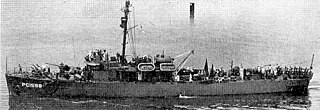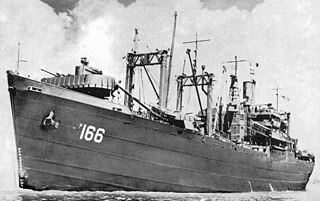
USS Gato (SS-212) was the lead ship of her class of submarine in the United States Navy. She was the first Navy ship named for the common name used for a number of species of catshark. She was commissioned only days after the declaration of war and made thirteen combat patrols during World War II. She survived the war and spent the post-war period as a training ship before being sold for scrapping in 1960.

USS Long (DD-209/DMS-12), named for John Davis Long (1838–1915), Secretary of the Navy from 1897 to 1902, was a Clemson-class destroyer of the United States Navy.

USS Honolulu (CL-48) of the United States Navy was a Brooklyn-class light cruiser active in the Pacific War. Honolulu was launched in 1937 and commissioned in 1938. The ship served in the Battle of Tassafaronga, the Battle of Kula Gulf, the Battle of Kolombangara and the Battle of Peleliu. She was taken out of action by serious torpedo damage just before the Battle of Leyte Gulf. She was repaired, but not in time to rejoin the war. She was decommissioned in 1947 and was held in reserve until she was scrapped in 1959.

USS Scabbardfish (SS-397), a Balao-class submarine, was the only ship of the United States Navy to be named for the scabbarddfish, a long, compressed, silver-colored fish found on European coasts and around New Zealand. In 1965 she was transferred to the Hellenic Navy and renamed Triaina.

USS Pintado (SS-387/AGSS-387), a Balao-class submarine, was the first ship of the United States Navy to be named for the pintado.

USS Williamson (DD-244/AVP-15/AVD-2/APD-27) was a Clemson-class destroyer in the United States Navy during World War II. She was named for Commander William Price Williamson.

USS Gillis (DD-260/AVD-12) was a Clemson-class destroyer in the United States Navy. She was named for Commodore John P. Gillis and Rear Admiral James Henry Gillis.

USS Guest (DD-472), a Fletcher-class destroyer, was a ship of the United States Navy named for Commodore John Guest (1822–1879).

USS Halford (DD-480), a Fletcher-class destroyer, was a ship of the United States Navy named for Lieutenant William Halford (1841–1919), a recipient of the Medal of Honor.

The third USS Perry (DD-340/DMS-17) was a Clemson-class destroyer in the United States Navy following World War I. She was one of eight ships named for Oliver Hazard Perry.

The second USS Gridley (DD-380) was the lead ship of her class of destroyers in the United States Navy. She was the second US Navy ship named for Charles Vernon Gridley. She served with distinction in the Pacific Theater during the Second World War and shared in the sinking of a Japanese submarine.

USS Patterson (DD-392), a Bagley-class destroyer, was the second ship of the United States Navy to be named for Daniel Todd Patterson, an officer of the US Navy who served in the Quasi-War with France, First Barbary War, and the War of 1812.

USS Case (DD-370) was a Mahan-class destroyer in the United States Navy before and during World War II. She was the second ship named for Augustus Ludlow Case.

USS Sproston (DD-577) was a Fletcher-class destroyer of the United States Navy. She was the second ship named for US Naval Lieutenant John G. Sproston, who was killed in action while leading an attack on a Confederate ironclad during the American Civil War.

USS Savage (DE-386) was an Edsall-class destroyer escort built for the United States Navy during World War II.
USS Annoy (AM-84) was an Adroit-class minesweeper of the United States Navy. She was laid down on 3 December 1941 at Portland, Oregon, by the Commercial Iron Works; launched on 6 April 1942; and commissioned on 2 September 1942, with Lt. John A. Parrish in command. In 1944 she was reclassified as a patrol craft and renamed PC-1588.

USS Excel (AM-94) was an Adroit-class minesweeper of the United States Navy. Laid down on 19 December 1941 by the Jakobson Shipyard, Inc., Oyster Bay, Long Island, New York, launched on 10 May 1942, and commissioned on 11 December 1942. The ship was reclassified as a submarine chaser, PC-1598 on 1 June 1944.
USS Buoyant (AM-153) was an Admirable-class minesweeper built for the U.S. Navy during World War II. After service in the Pacific, which netted her crew one battle star, she was decommissioned in May 1946 and sold to the Republic of China. Her name in Republic of China Navy service and her fate are not reported in secondary sources.

USS Richard S. Bull (DE-402) was a John C. Butler-class destroyer escort in service with the United States Navy from 1944 to 1946. She was finally sunk as a target in 1969.

The third USS Comet (AP-166) was a United States Navy La Salle-class transport in commission from 1944 to 1946. She saw service in the Pacific Theater of Operations during the latter stages of World War II and the immediate postwar period.


















